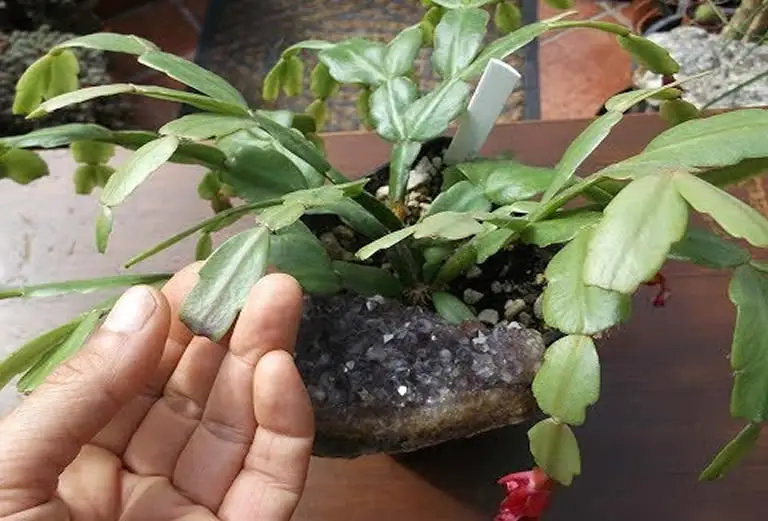In this article I outline everything you need to know to treat christmas cactus leaf problems. This guide will help you identify the cause of the most common christmas cactus problems so you can apply the included easy fixes to maintain healthy foliage on your succulent cactus plant.
Table of Contents
- Common christmas cactus problems & their solutions
- 1. What to do when a cactus goes limp
- 2. What to do when a cactus begins turning yellow
- 3. What to do when a cactus begins turning white
- 4. What to do when a cactus begins turning red
- 5. What to do when a cactus is turning purple
- 6. What to do when a cactus is turning brown
- 7. Causes for christmas cactus leaves falling off
- 8. Christmas cactus root rot causes & cure
- 9. How to get rid of bugs on christmas cactus
- 10. Why buds fall off christmas cactus and what to do about it
Common christmas cactus problems & their solutions
Below you will find both the causes of, and the cures for, the most common christmas cactus problems encountered with this specific cactus succulent.
Feel free to go directly to the section that is connected to your plant’s specific problem. Be aware though that reading through the entire article will arm you with all the knowledge you need to properly care for your christmas cactus plant should you encounter future problems.
This is especially the case if you grow these cacti as houseplants.
1. What to do when a cactus goes limp
Limp or drooping leaves on a christmas cactus are almost always the result of overwatering.
Christmas cactus, like all cacti, can go for long periods without water but giving the plant too much water can create serious problems.
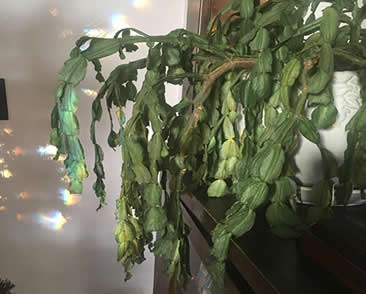
As I outlined in our christmas cactus watering guide, as a general rule-of-thumb this specific cactus plant should be watered only once every 3 weeks if it is grown indoors, under normal household conditions.
Watering the plant more than that can lead to some very serious problems.
The dropping of leaves is often just a symptom of a much more serious problem.
Why leaves on a christmas cactus go limp
Although limp leaves can on occasion indicate that a christmas cactus has been underwatered, due to the plant’s drought resistance this is a very rare thing.
It is much more likely that the cactus has been overwatered.
You see the signs of overwatering and underwatering in a plant are the same – dehydration.
I know this sounds counterintuitive but there are very specific reasons for why a cactus (or any plant) can become dehydrated when it gets too much water. I will cover those reasons later in this article at the appropriate point.
When a christmas cactus has been watered to much the first signs will be drooping leaves.
If you catch this problem early enough then there should be no long term damage done to the plant.
Simply allowing the plant soil to dry out (or better still, repotting the plant in fresh soil) may be enough to fix the issue.
However, more often than not drooping limp leaves are a sign that there has already been damage done to the root system.
So, at the first sign of drooping leaves you should check the plant’s soil for moisture.
By sticking your finger into the soil to a depth of a few inches (up the first knuckle of your first finger) you can check the amount of moisture in the soil.
If your finger comes out completely dry then the soil is dry. However, if there is dirt residue on on your finger then there is moisture in the soil.
I have found that 9 times out of 10 I will find that the soil still contains moisture when a christmas cactus has limp leaves and this is a strong indication that the plant has been overwatered.
How to stop and prevent a christmas cactus becoming limp
Soil can dry out because you have not watered the plant in over 3 weeks or due to the environment being particularly dry and hot.
If the soil that your christmas cactus is growing in is completely dry then water the plant.
Water it from the bottom by placing the pot in a few inches of water for about 20 minutes.
The soil will soak up the water from the holes in the bottom of the pot.
If, after doing this, the plant does not show a positive reaction over the next few days then the problem was not underwatering. You should therefore check the roots for root rot or disease (see section below).
Likewise, if you find that the soil of a drooping christmas cactus plant does actually contain moisture then you must check the plant for root rot.
As you will see later this involves removing the plant from its pot and inspecting its roots for damage.
2. What to do when a cactus begins turning yellow
It can be upsetting and very frustrating when the foliage on your christmas cactus plant starts losing its luster.
The yellowing effect that sometimes occurs on the leaves of a christmas cactus has two potential causes, each of which are easily fixed.
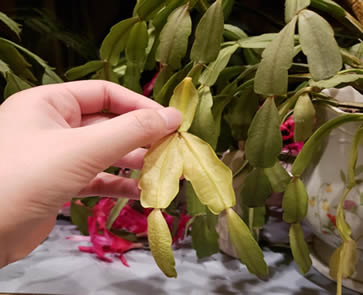
The image above shows a christmas cactus plant that has leaves which are becoming pale and slowly turning yellow.
If your plant is showing similar symptoms then you will be pleased to know there are easy fixes.
Before I outline how to treat a yellowing christmas cactus but you need to first know what is causing the loss of pigmentation in the leaves so you can apply the appropriate fix.
Why a christmas cactus turns yellow
There are 2 potential causes for christmas cactus leaves turning yellow. They are:
- Leaf scorching.
- Underwatering.
Although christmas cactus plants are desert succulents they do not like full sun as many other desert succulents do (like an aloe plant for instance).
Christmas cacti grow naturally in partial shade on trees and in rocky areas and so they have evolved to grow best in indirect light.
If left in direct sun for long periods the UV rays will burn the foliage and cause it to turn yellow.
Although too much sun can cause a christmas cactus to turn yellow another common cause of this problem is underwatering.
Without enough moisture in the soil the plant becomes dehydrated and starved of nutrients (the nutrients are carried to the foliage via water).
So how do you treat these problems once you have identified which one is the cause for the yellowing of the leaves on your specific christmas cactus?
How to stop and prevent a christmas cactus turning yellow
Let’s first look at the problem of leaf scorching.
If your christmas cactus is located in an area that gets direct sunlight move it to a location that gets only indirect light.
Christmas cactus require a minimum of 8 hours of indirect light per day, though more is better.
However, be aware that this succulent also requires a minimum of 12 hours of complete darkness every day. So be sure to place your plant in an appropriate location where it isn’t getting too much or too little light.
For more information on both the light, humidity and temperature requirements of the christmas cactus read this guide.
If the lighting is not the issue and you find that your plant is suffering from a lack of water the fix is obvious – water the plant.
Be sure to water the plant from the bottom leaving it to soak up moisture for about 20- minutes only.
Also keep in mind that christmas cacti love humid environments.
So, place the pot on a tray filled with both water and pebbles to ensure the localized environment around the plant remains humid.
I also advise you to use terracotta pots with christmas cactus plants (and any other plants that require high humidity levels).
Terracotta sweats moisture from the soil, both helping to maintain good water drainage and also helping to create humidity directly around the plant because the sweated water evaporates from the outside of the pot.
A word of caution: Be absolutely sure your christmas cactus has been underwatered before watering it.
Dehydration and nutrient-deficiency can also be caused by root rot which is a serious symptom of overwatering.
Always check the moisture levels in the soil before assuming any plant has been underwatered – especially with succulents.
Use the finger test that I outlined earlier in this article to check the moisture levels in the soil.
3. What to do when a cactus begins turning white
When a christmas cactus turns white the caucuses are the same for when the foliage starts to turn yellow.
When the leaves are white the effects are just the result of leaving the plant untreated for a longer period. Leaving a christmas cactus that is turning yellow untreated will mean the foliage eventually turns very pale with either a white look or very pale look.
Why christmas cactus starts turning white
Christmas cactus plants will turn white due to leaf scorching or underwatering.
If left in direct sunlight the UV rays can bleach the color from the leaves.
Underwatering can also rob the foliage of nutrients needed to maintain color pigmentation.
So how do you treat a christmas cactus that has yellowing foliage?
How to stop and prevent a christmas cactus from turning white
You must first identify the cause behind the change in foliage color.
Is it too much sun or too little water?
As a whitening of the leaves is just a progression from a yellowing of the leaves you should apply the same fixes I outlined above for treating christmas cactus plants that are turning yellow.
See the section above on “christmas cactus turning yellow – cures”.
4. What to do when a cactus begins turning red
Pigmentation changes in the foliage of a christmas cactus usually lie in lack of nutrients in the soil or incorrect light exposure.
Why your christmas cactus is turning red
So what are the causes for leaves turning red on a christmas cactus?
Leaf scorching can turn a christmas cactus red when the plant is left in strong direct sunlight and the leaf becomes “sunburned”.
Also, when christmas cactus soil lacks magnesium the foliage will often start to turn red as the plant develops a magnesium deficiency.
How to stop and prevent a christmas cactus from turning red
If you have identified the cause of the reddening of the leaves to be related to incorrect lighting you should move your christmas cactus plant away from sources of direct sunlight.
Many christmas cactus plants that are grown on window ledges, that get many hours of strong direct sun, will develop pigmentation issues on the foliage.
Also keep in mind that this particular desert cactus prefers indirect light.
Ensure you move the cactus to a location that gets a minimum of 8 hours of indirect light per day and at least 12 hours of darkness.
So what do you do if your plant is already located in the ideal spot?
If your christmas cactus is already located in an area that gets good indirect light then it is likely a lack of magnesium in the soil that is causing the reddening of the leaves.
A quick fix for a lack of nutrients is to add a good quality cactus fertilizer but I would also recommend repotting your christmas cactus in fresh soil as it may also be root bound.
By repotting in fresh soil (and perhaps a slightly bigger pot) you will not only help to replenish lost nutrients but you will also allow the roots room to grow.
You should also add some epsom salts to the fertilizer as this will replenish the lost magnesium in the soil. Mix it at 1 teaspoon per gallon of water.
Even if you repot your cactus I advise you to still fertilize it and maintain a fertilization routine of one feed every 2 weeks until the foliage regains its natural color.
Then switch to fertilizing once every 3 weeks during growing season only.
You can read more about the importance of magnesium and fertilizer when it comes to blooming in our article how to make christmas cactus bloom.
5. What to do when a cactus is turning purple
What about purple leaves? What are the causes when leaves turning purple on a christmas cactus?
Leaf scorching can turn a christmas cactus purple when the plant is left in strong direct sunlight.
Also, when christmas cactus soil lacks phosphorus the foliage will often start to turn purple as the plant develops a deficiency.
Why your christmas cactus is turning purple
Just like a reddening of the leaves, purple leaves can be caused by over-exposure to strong direct sunlight.
In fact in many cases these two symptoms are actually the same as it is only a person’s perception of the color (some thinking its red while others thinking its purple) that makes it red or purple.
Not always though.
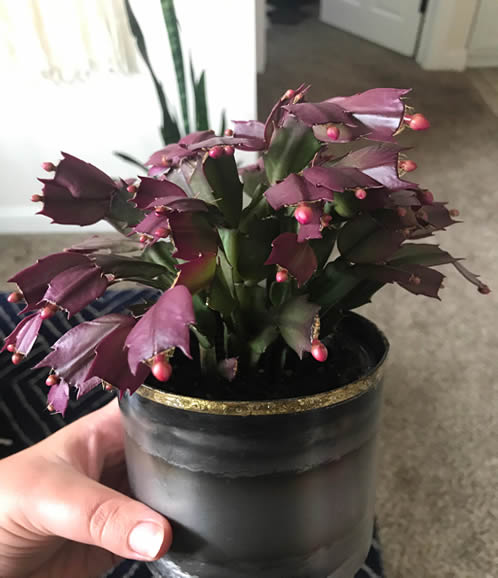
Deep purple leaves on a christmas cactus plant can also be caused by a lack of phosphorus in the soil.
How to stop and prevent your christmas cactus turning purple
Just as you would do with a christmas cactus that is turning red be sure to relocate the plant away from strong direct sunlight.
Place it somewhere that gets at least 8 hours of good indirect light per day and a minimum of 12 hours of darkness at night.
If the plant is already located in an ideal location then you should repot it in fresh soil and consider using a slightly bigger pot to allow the roots room to grow.
Fertilize the plant once every 2 weeks with the type of fertilizer I mentioned above until the plant regains its natural color. Then return to a normal fertilization routine.
6. What to do when a cactus is turning brown
It can be alarming and disheartening when your beloved christmas cactus houseplant starts to turn brown – I know because it has happened to me.
Often this browning effect is accompanied by a drying of the leaves.
This is an effect of dehydration more often than not and the dehydration is almost always caused by root rot which is a direct result of giving the cactus too much water.
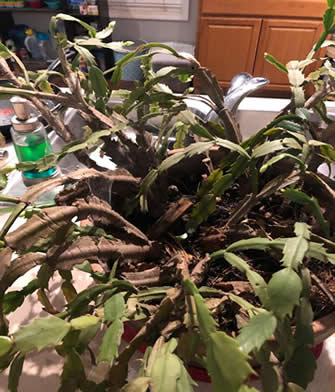
Let’s look at the main contributing factors for root rot that makes christmas cactus leaves turn brown and their fixes.
Why your christmas cactus is turning brown
When a christmas cactus has foliage that starts to turn brown it is almost always a sign of root rot.
However, if there are only brown spots on the leaves then this is a sign of leaf scorching from direct sunlight.
Leaf scorching is easily fixed by moving the plant to an area of indirect light. Root rot is much more serious and requires extensive measures to save the plant.
It is easy to see the difference between brown spots on the foliage and completely brown leaves.
Leaves with brown spots are usually otherwise healthy while a christmas cactus with brown leaves looks sickly and in distress.
How to stop and prevent your christmas cactus turning brown
If your christmas cactus has brown spots on the leaves then you need to relocate your plant.
Brown spots are signs that the cactus is getting too much strong direct sunlight.
Christmas cactus will thrive in indirect light, and will even grow happily in shade (though they may not bloom), however they need a minimum of 8 hours of this indirect light per day.
Although more than 8 hours of daily indirect light will help your christmas cactus to thrive and bloom better bear in mind that this succulent also requires at least 12 hours of darkness every night.
If the entire plant is turning brown, or parts of the foliage are completely brown, then the plant is almost certainly suffering from root rot.
It must be treated immediately if you want to save it as root rot is lethal to all plants.
Follow the directions given below for treating a christmas cactus with root rot.
7. Causes for christmas cactus leaves falling off
There can be outlying causes for a christmas cactus dropping leaves, such as insufficient lighting and incorrect temperatures (see our christmas cactus light requirements guide for light and temperature needs) but when it comes to houseplants these are seldom the cause for leaf loses.
When a christmas cactus starts to lose leaves it is usually a strong indication that there is a problem with the plant’s roots.
Root problems can be causes by bugs (see the section below) but more often than not the cause is root rot.
8. Christmas cactus root rot causes & cure
Christmas cactus root rot is a serious problem.
If you suspect your plant is suffering from this condition then you must take immediate action or you run the risk of losing the cactus.
Root rot acts quickly to rob your plant of water and nutrients. As the rot eats away at the roots they become unable to absorb moisture from the soil and distribute it to the rest of the plant, leading to plant dehydration.
As counterintuitive as it sounds this dehydration is usually caused by giving the plant too much water.
When you give any type of cacti too much water the soil becomes drenched and soaked.
Cacti, like almost all succulents, have evolved to grow in water-scarce environments.
So, if cacti roots are forced to sit in a water-heavy soil they will begin to rot.
How can you tell if your christmas cactus is suffering from root rot?
What does root rot look like on a christmas cactus?
The signs of root rot on a christmas cactus are fairly easy to spot.
Root rot on a christmas cactus can be identified in the leaves. The leaves will be limp and may be mushy and brown at their base.
Leaves will also often turn brown or black. The roots of the plant when inspected will be blackened and either mushy or completely dry and dead.
The first sign of root rot on a christmas cactus is limp or drooping leaves.
This occurs because the roots become unable to supply moisture to the foliage and the plant starts to become dehydrated.
Along with drooping leaves you will often also see a browning of the leaves and weakening of the leaf stem at its base.
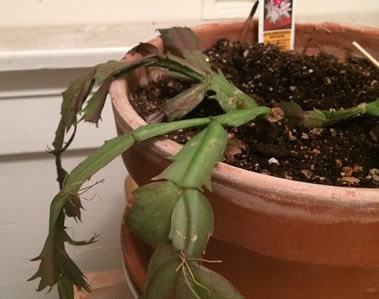
The lower part of the leaf stem can become dark and mushy and the entire stem may come away from the plant easily with just a touch.
If you suspect your christmas cactus has root rot but there are no major telltale signs in the foliage, such as browning mushy leaf stems, then you must remove the plant from its pot and visually inspect the roots.
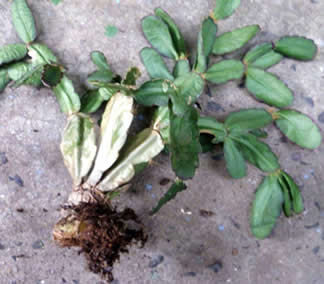
As you can see in the image the the roots of this christmas cactus have darkened and become black.
How to save a christmas cactus with root rot
To save a christmas cactus from root rot you must first identify the problem that is causing the rot. In most cases it will be due to overwatering but it could also be due to bug infestations.
If you find evidence of bugs on the plant then you should treat the cactus with an appropriate insecticide (see section below) before performing the actions I outline here.
Failure to do this will mean the bug eggs which remain on the plant after you repot it will hatch new bugs and you will have another infestation on your hands.
If there are no signs of infestation and the problem was overwatering then there is no need to use an insecticide.
Steps to save a christmas cactus with root rot:
- Remove the plant from its pot.
- Inspect the roots and remove all rotted areas with scissors or a knife.
- Clean up the root ball making sure no rotted parts remain on the plant. In extreme cases this may mean removing the entire root ball.
- Replant the cactus in fresh slightly moist soil but do not water the plant for several weeks.
- Place the plant in a location that gets daytime temperatures of about 70°F.
- Ensure the cactus gets at least 10 hours of good indirect light per day or consider using a grow light.
- If the cactus has lost most of its root system then consider placing a grow bag (or tent) over the plant to maintain good humidity levels and higher temperatures until the cactus shows signs of new growth.
In a previous article, where I gave detailed instructions on how to treat aloe vera root rot, there are clear steps along with pictures, showing you how to treat succulents for root rot. Because the aloe plant is also a desert succulent like the christmas cactus, the advice contained within that article applies equally well to treating root rot in a christmas cactus. So if you feel you need a detailed walkthrough of how to treat root rot in your christmas cactus read that article.
9. How to get rid of bugs on christmas cactus
Bugs are a nuisance on houseplants but some can cause more damage than others. Take the fungus gnat as a prime example.
The symptoms of fungus gnat attacks are the same as those of overwatering – limp leaves and a browning of leaves.
Although there are other pests that like nothing better than to feed off your cacti houseplants, such as mealybugs spider mites and scale insects, it is fungus gnats that attack the roots of a christmas cactus and they must be eliminated before root treatment is started.
You may also encounter christmas cactus brown scale which should also be eliminated before root treatment is administered to your plant (if it needs it).
Luckily, using a good natural insecticide will remove all types of pests from a christmas cactus plant.
However, if your plant has a infestation of fungus gnats then you must also treat the plant for root rot as merely eliminating the pest infestation will not be enough to save the plant.
This is by far the best product I have used for eliminating fungus gnats and it works equally well on all other pests.
If you find the plant is suffering from an infestation of fungus gnats then be sure to follow the instructions in the section above for treating the christmas cactus root rot. But do this only after you have used an insecticide to remove the bug infestation.
10. Why buds fall off christmas cactus and what to do about it
Losing buds from a christmas cactus is a very common problem encountered with houseplant owners.
There can be several reasons for buds falling off a christmas cactus.
The most common causes are incorrect watering, incorrect lighting and incorrect environmental temperatures, though pest infestation can also be a problem.
Christmas cactus should be watered once every three weeks, get at least 8 hours of indirect light per day and be placed in a location that has temperatures between 65°F – 75°F.
Pests should be treated with a natural insecticide.
The first thing to do is to check your cactus for pests.
If you find evidence of a bug infestation use an insecticide like the one I mentioned above or a similar product to eliminate the problem.
If the plant is pest-free then the likely cause for the loss of buds will be one of the following.
3 causes for loss of buds on a christmas cactus:
- Incorrect watering routine (usually giving the plant too much water).
- Incorrect lighting (usually not giving the plant enough indirect light).
- Incorrect environmental temperatures below 33°F or above 90°F.
If you are unsure which of the above three causes is to blame for the loss of christmas cactus buds read this article in its entirety.
This will help you to identify the exact cause of the problem and in each section you will either find the cure or a link to an article with the exactly fix.
If you want more information on caring for christmas cactus and growing it indoors read this article.

